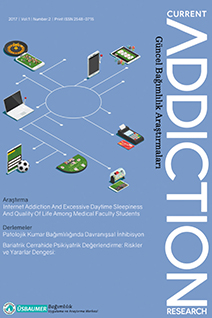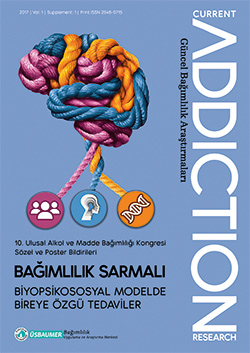Years
2025
2023
2017
Categories
Authors
ARTICLES
Original Article
Azize TÜRKOĞLU,Cemal Onur NOYAN
2025, 9(1), s:5-14
Objective: The aim of this study is to examine the relationship between exam anxiety levels and smartphone addiction levels of secondary school students.
Method: This study was designed using the relational survey model from quantitative methods. The population of the study consists of students studying at the secondary school level in Istanbul between 2023-2024. The sample of the study consists of 417 students selected by simple random sampling method. In the study, Personal Information Form was used to evaluate demographic characteristics, ‘Westside Test Anxiety Scale’ was used to measure the level of test anxiety and ‘Smartphone Addiction Scale-Short Form’ was used to measure the level of smartphone addiction. The research data were analysed using SPSS 27.00 package programme.
Findings: It was determined that there was a positive, weak-medium significant relationship between test anxiety levels of secondary school students and smartphone addiction. In addition, it was determined that there was a significant relationship between test anxiety level and gender, parental attitude, school achievement, parents' attitude towards success, and duration of smartphone use. It was determined that there is a significant relationship between smartphone addiction and time alone, duration of smartphone use, school achievement, parents' attitude towards success.
Conclusion: There is a significant relationship between test anxiety and smartphone addiction in adolescent secondary school students. This indicates that there is a need for prevention studies and psychoeducation for students, teachers and parents in secondary schools for test anxiety and smartphone addiction.
Original Article
Investigation of the Relationship Between Social Media Use and Life Satisfaction Level
Şule DOYAROĞLU,Cemal Onur NOYAN
2023, 7(2), s:5-12
In this study, the relationship between social media use disorder and life satisfaction in adults was examined. 221 adult individuals participated in the study. Sociodemographic Information Form, Social Media Addiction Scale (SMAS) and Satisfaction with Life Scale were applied to the participants. The survey responses of the participants were entered into SPSS 28.0 package software and statistical analyzes were conducted. Independent sample t-test and one-way ANOVA were applied for comparisons in terms of sociodemographic variables. Pearson correlation was applied to examine the relationship between social media use disorder and life satisfaction. Multiple regression analysis was applied to examine the prediction of life satisfaction by social media. use disorder to the findings of the study, male participants had higher social media use disorder scores than female participants. On the other hand, as the time spent on social media and the number of social media applications increased, social media use disorder scores increased. On the other hand, the social media use disorder scores of single participants and participants reporting low education level were found to be significantly higher. When the findings related to life satisfaction were analyzed, it was found that the life satisfaction scores of the participants who were married, had a higher income level and were employed were significantly higher. When the relationship between life satisfaction and social media use disorder scores was analyzed, it was found that there was a significant relationship between the increase in social media scores and the decrease in life satisfaction scores. In addition, it was found that the conflict sub-dimension of social media use disorder predicted life satisfaction negatively and significantly. The findings of the study are expected to contribute to future applications and researches in terms of understanding the factors related to social media use, which has become an indispensable part of daily life.
Original Article
Ceren GÜNGÖR,Cemal Onur NOYAN
2023, 7(2), s:13-18
Objective: This study was designed to investigate the relationship between family involvement, stigmatization, perceived social support, and treatment motivation in drug addiction treatment.
Method: The participants of our study consisted of individuals receiving substance use disorder treatment at the NP Brain Hospital AMATEM service and the Green Crescent Counseling Center (YEDAM). The research included a total of 98 voluntary participants, including 88 males and 10 females, aged 18 and above, receiving substance use disorder treatment. Among the participants, 57 had family involvement in the treatment, while the remaining 41 did not have their families involved in the treatment process. Data were collected using the Personal Information Form, the YEDAM Substance Addiction Stigmatization Scale (YMBSÖ), the Multidimensional Perceived Social Support Scale (ÇBADÖ), and the Treatment Motivation Questionnaire (TMA).
Results: When the results were evaluated, a significant relationship was found between the family subscale of perceived social support and the treatment confidence subscale of the treatment motivation questionnaire. Among the subscales of the Treatment Motivation Questionnaire, the score for seeking interpersonal help was higher in patients whose families were involved in the treatment. When the stigma scores of participants living alone were compared with those living with their families, it was concluded that individuals living alone had higher stigma scores.
Conclusion: The findings from our study have shown that substance addiction negatively affects many essential aspects of patients' lives, such as their social relationships, family and environmental connections, as well as their work and academic lives. Substance addiction, which is becoming an increasingly significant societal issue, requires a multidisciplinary approach that involves not only medical treatment but also the involvement of families and society in order to regulate individuals' social lives, education and work lives, and family and environmental relationships.
Original Article
Zeynep Ülke,Cemal Onur Noyan,Nesrin Dilbaz
2017, 1(1), s:16-25
Objective: The objective of this study was to adapt the “Bergen Facebook Addiction Scale (BFAS)” developed by Adreassen et al (1) into Turkish, and to evaluate the reliability and validity of the Turkish version of the Bergen Facebook Addiction among university students.
Method: The study was conducted in 2015 at Uskudar University and Yeditepe University (Istanbul-Turkey) with a total of 300 students from different majors and age groups. The draft scale was finalized after being translated and corrected by experts in the relevant fields. To determine the validity of the scale; factor analysis was performed and the results revealed that, of the 6 items reflecting the six core elements. It was detected that all items were distinctive with respect to relationship of each item with its related factor. Reliability level was determined by test – retest and internal consistency analysis. In addition, to test the criterion dependence validity of the scale, the correlation between the data gathered from Bergen Facebook Addiction Scale was analyzed respectively with data collected from the Smartphone Addiction Scale, Facebook Use Variance and Facebook Addiction Self-evaluation.
Results: The internal consistency coefficient was calculated using the Cronbach’s Alpha formula and gave a result of crα= .89. The 3-week test-retest validity Cronbach’s alpha was .76 for the six-item Bergen Facebook Addiction Scale. The factor analysis and testretest results confirmed the reliability and validity of the 6-item scale.
Conclusion: Bergen Facebook Addiction Scale is able to measure reliably, and the scale is a valid and reliable tool to be employed in a clinical environment to predict addiction levels of individuals regarding Facebook use in the Turkish society as well.
Original Article
Treatment And Approaches On Acute Agitation Among in Patients in a Private Psychıatry Hospital
Aslı Enez Darçın,Cemal Onur Noyan,Serdar Nurmedov,Hasan Kaya,Nesrin Dilbaz
2017, 1(1), s:26-32
Aim: It is aimed to determine the association between the indications of acute agitation call, applied treatment, applied restraint and seclusion with the
sociodemographical and clinical characteristics of psychopathology.
Method: Among inpatients in a private psychiatry hospital, medical records of whom has a form filled for acute agitation between June 2013-April 2014 examined
retrospectively, 137 medical records enrolled. Acute intervation form and brief psychiatric rating scale points that had been filled in the same day were determined.
Results: In the duration of the study acute agitation call applied for 16.4% of inpatients, 1.9% were restrained, 8% were secluded and 9.4% were given acute medication.
While the applied physical restraint and seclusion rates did not differ during the day, drug applications were found in higher rates during daytime hours (p<0.05). According to the hours of application, the duration of physical restraints were constant throughout the day while the duration of seclusions were longer in the night hours (p<0.05). The most common causes of acute agitation were aggression, threat of violence and treatment rejection. There was no difference approaches to acute agitation in terms of the diagnosis. The majority of selected drug treatments for acute agitation were intramuscular injections. No association was found between scale scores and the duration of any application.
Conclusion: Lower rates of restraints in our study could be associated with that the sample of this study was chosen from a private psychiatry hospital. There is need
for further training among treatment team and studies in this area to shed light on the development of approaches.



 2. Sayı
2. Sayı
 1. Sayı
1. Sayı
 Ek Sayı
Ek Sayı







